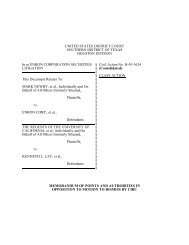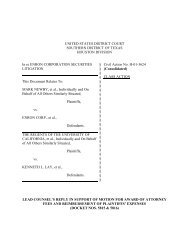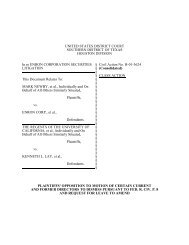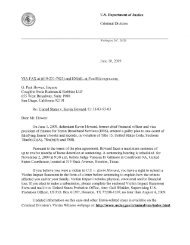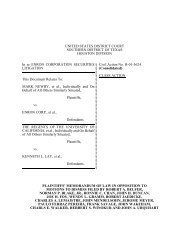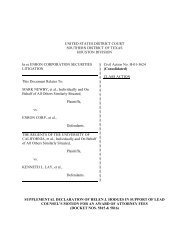Declaration Of Helen J. Hodges In Support Of Lead Counsel's ...
Declaration Of Helen J. Hodges In Support Of Lead Counsel's ...
Declaration Of Helen J. Hodges In Support Of Lead Counsel's ...
Create successful ePaper yourself
Turn your PDF publications into a flip-book with our unique Google optimized e-Paper software.
the market in October 2001. The analysis showed 29 Enron insiders had sold 17.3 million Enron<br />
shares before Enron’s implosion in fall 2001, resulting in illegal insider trading proceeds of $1.1<br />
billion.<br />
44. On December 5, 2001 <strong>Lead</strong> Counsel filed an ex parte application for a temporary<br />
restraining order (“TRO”) imposing a constructive trust over the $1.1 billion in insider trading<br />
proceeds. <strong>Lead</strong> Counsel also sought an accounting of the Enron defendants’ gains and sought<br />
limited expedited discovery under the PSLRA pursuant to 15 U.S.C. §78u-4(b)(3).<br />
45. <strong>Lead</strong> Counsel’s ex parte application explained how Enron and its executives<br />
concealed their fraud until Enron declared bankruptcy on December 2, 2001 and why Enron’s<br />
financial statements from 1997 through the second quarter of 2001 were false and misleading,<br />
overstating Enron’s financial results by billions of dollars. The ex parte application included<br />
opinions from two knowledgeable experts in securities fraud and the federal securities laws.<br />
46. <strong>Lead</strong> Counsel detailed the insider trading of numerous Enron executives, including<br />
Lay, Skilling, Fastow, Richard Causey (“Causey”), Lou Pai (“Pai”), Harrison, and others. <strong>Lead</strong><br />
Counsel’s ex parte application explained how the federal securities laws provided for equitable<br />
disgorgement of defendants’ insider trading proceeds. The ex parte application sought limited<br />
expedited discovery, in part because defendants had used offshore partnerships and illicit straw<br />
entities to accomplish the Enron fraud. <strong>Lead</strong> Counsel also explained why discovery should not be<br />
stayed under the PSLRA. Other plaintiffs joined in support of <strong>Lead</strong> Plaintiff’s TRO application.<br />
47. Defendants opposed the ex parte application for a TRO, stating plaintiffs were<br />
attempting an “end-run” around the PSLRA and its discovery stay. Defendants further argued<br />
plaintiffs were not entitled to a “prejudgment restraint” on defendants’ assets absent a lien or viable<br />
equitable interest in the insider trading proceeds. Defendants filed a subsequent joint brief, again<br />
arguing plaintiffs had no “equitable interest” in the $1.1 billion in insider trading proceeds.<br />
- 27 -



